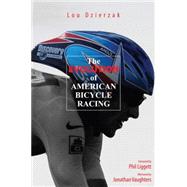
| Comments | p. vii |
| Acknowledgments | p. viii |
| Foreword | p. ix |
| Introduction | p. 1 |
| Timeline | p. 4 |
| The Early Years of American Bicycle Racing | p. 10 |
| Bicycle Racing's First Stars | p. 11 |
| Who Is the Fastest American Cyclist? | p. 11 |
| Early Heroes | p. 12 |
| Track Stars | p. 15 |
| The Six-Day Grind | p. 18 |
| The Racers Take Control | p. 25 |
| The World War II Era | p. 26 |
| The Tour of Somerville | p. 28 |
| Fitchburg Longsjo Classic | p. 34 |
| The Rebirth of American Bicycle Racing | p. 36 |
| Champions of the Road | p. 37 |
| Road Racing Returns to the Front Page | p. 38 |
| The Business of Cycling | p. 40 |
| The Growth of International Competition | p. 41 |
| Americans at the World Championships | p. 44 |
| The Numbers Skyrocket | p. 55 |
| The New Professionals | p. 59 |
| The Shimano Team | p. 59 |
| The Rebirth of Track Racing | p. 60 |
| The 1970s Bring Changes | p. 69 |
| Olympic Dreams on America's Bicentennial | p. 71 |
| The Rising Stars of the Late '70s | p. 73 |
| The Rise of Sponsorship | p. 79 |
| The Decade of Firsts | p. 79 |
| The Tour of Texas | p. 80 |
| The Sponsorship Game | p. 82 |
| Redlands Classic | p. 87 |
| Tour of the Americas | p. 90 |
| The Fight for Control of Professional Racing | p. 92 |
| Olympic Dreams Lost and Found | p. 97 |
| America's Golden Olympics | p. 97 |
| Blood Doping Scandal | p. 98 |
| Back to Reality | p. 99 |
| The Pursuit of Olympic Gold | p. 100 |
| Administration and Insurance | p. 115 |
| Bicycle Racing in the Modern Era | p. 118 |
| America's Growing Competitiveness | p. 119 |
| The World Takes Notice | p. 119 |
| Andy Hampsten and 7-Eleven | p. 120 |
| Hampsten il Conquistatore | p. 121 |
| Americans in Paris | p. 123 |
| The Pan American Games Come to Indianapolis | p. 125 |
| The Pan American Games | p. 125 |
| America's First Homegrown Racing | p. 135 |
| The Coors Classic | p. 136 |
| The "America's Tour" | p. 137 |
| Turning Pro | p. 147 |
| Racing for the Stars and Stripes | p. 147 |
| The CoreStates USPRO Cycling Championship | p. 148 |
| The USPRO Championships | p. 149 |
| The Tour de Trump | p. 156 |
| The Tour DuPont | p. 158 |
| The Pros in the '90s | p. 162 |
| The Women's Challenge | p. 164 |
| The Lance Armstrong Era | p. 173 |
| A Rising Star at the 1991 National Championships | p. 173 |
| Corporate Teams | p. 174 |
| Races of the Early '90s | p. 175 |
| The Fight for Control of Professional Racing | p. 178 |
| Americans in the Tour de France | p. 181 |
| Lance Armstrong's Saga | p. 207 |
| Racing in the Next Millennium | p. 217 |
| Dark Shadows | p. 217 |
| Doping, Drugs, and Scandals: Searching for a Competitive Edge | p. 218 |
| New Sponsors | p. 225 |
| New Races | p. 227 |
| New Heroes | p. 229 |
| Afterword | p. 233 |
| Index | p. 235 |
| About the Author | p. 245 |
| Table of Contents provided by Ingram. All Rights Reserved. |
The New copy of this book will include any supplemental materials advertised. Please check the title of the book to determine if it should include any access cards, study guides, lab manuals, CDs, etc.
The Used, Rental and eBook copies of this book are not guaranteed to include any supplemental materials. Typically, only the book itself is included. This is true even if the title states it includes any access cards, study guides, lab manuals, CDs, etc.
Excerpted from The Evolution of American Bicycle Racing by Lou Dzierzak
All rights reserved by the original copyright owners. Excerpts are provided for display purposes only and may not be reproduced, reprinted or distributed without the written permission of the publisher.